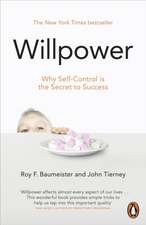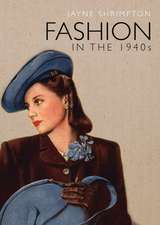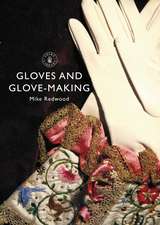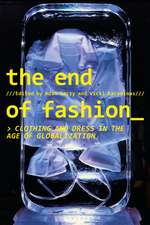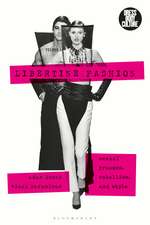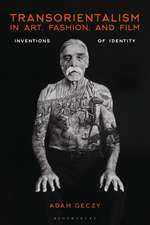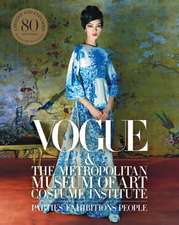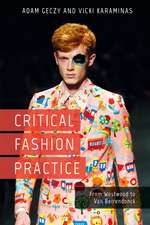The Artificial Body in Fashion and Art: Marionettes, Models and Mannequins
Autor Adam Geczyen Limba Engleză Paperback – 2 noi 2016
Preț: 180.88 lei
Preț vechi: 208.90 lei
-13% Nou
Puncte Express: 271
Preț estimativ în valută:
34.62€ • 37.62$ • 29.10£
34.62€ • 37.62$ • 29.10£
Carte tipărită la comandă
Livrare economică 21 aprilie-05 mai
Preluare comenzi: 021 569.72.76
Specificații
ISBN-13: 9781472595959
ISBN-10: 1472595955
Pagini: 216
Ilustrații: 40 bw and 19 colour illus
Dimensiuni: 169 x 244 x 13 mm
Greutate: 0.45 kg
Editura: Bloomsbury Publishing
Colecția Bloomsbury Academic
Locul publicării:London, United Kingdom
ISBN-10: 1472595955
Pagini: 216
Ilustrații: 40 bw and 19 colour illus
Dimensiuni: 169 x 244 x 13 mm
Greutate: 0.45 kg
Editura: Bloomsbury Publishing
Colecția Bloomsbury Academic
Locul publicării:London, United Kingdom
Caracteristici
A multidisciplinary study that combines fashion theory, cultural theory, art history and psychoanalysis to explore the historical and psychological construction of self through the body, appealing to students from a wide range of disciplines
Notă biografică
Adam Geczy is an artist and writer, and teaches at Sydney College of the Arts, the University of Sydney, Australia. He is the author and co-author of numerous books, the most recent being Fashion and Art (Berg, 2012) and Fashion's Double (Bloomsbury Academic, 2015).
Cuprins
Introduction1. Clothes of Carnival: Personal Puppeteering and Role Play2. A Soul in Control: The Art of the Automaton3. Dark Doubles: Dolls and the Fallible Body4. Between Torture and Transcendence: The Doll in Art5. A Model Subject: The Window Dummy, the Fashion Doll, and the Double6. Extreme Hellene: Sport, Superheroes and the Modern Übermensch7. Genetically Baroque Beings: Cybergender, Transexuality and Natrificiality8. Future Postscript: Shells and Ghosts, Bodies and SoulsConclusionNotesBibliographyIndex
Recenzii
The mixture and range of cultural forces at play in this scintillating manuscript takes us on a cultural magical mystery tour that is as exciting as it is surprising, as provocative as it is erudite, as original as it is imaginative, and as thrilling as it is perverse.
A profoundly innovative study that presents surprising and far-reaching insights into the complex intersections between the phenomenology of dolls, masquerade and marionettes and post-modern subjectivities.
Using several social science disciplines, Geczy undertakes a valuable overview of the changing significance of the doll in previous centuries and today. His analysis reveals important changes that are taking place in women's conceptions of the female body.
This book is a completely fascinating read that takes you far beneath the surface of appearances by stripping bare a myriad of meanings of dolls in our lives, from baby to adult. It makes you think, and re-think, by drawing on diverse histories of theatre, art, fashion, aesthetics, technology, religion, philosophy and psychoanalysis, literature, film, gender and cultural theory. Geczy brilliantly guides the reader in this rich account that cannot be pigeon-holed by discipline-it is a must read for all interested in the relationship between our minds, bodies and soul.
Painting a broad canvas Geczy provides a rich and detailed landscape that links ideas stretching from Jane Munro's Silent Partners: Artist and Mannequin from Function to Fetish - a cultural history that traces centuries of evolution of the artist's mannequin within the context of an expanding universe of effigies, avatars, dolls, and shop window dummies - to Yuval Harari's Sapiens: A Brief History of Humankind, which provides an evolutionary history of our species towards an unfolding future that witnesses the fusion between natural bodies and cyber limbs in a scientific odyssey involving non-organic-life engineering. Geczy adds an important piece in the jigsaw of the scholarship on dolls and masks, that examined the boundaries of the animate and inanimate in dolls and representations.
Readers of Geczy's book are in for a wild ride. The lavishly illustrated narrative moves in broad strokes from the commedia dell'arte to cyborgs, with grossout plastic surgery disasters and live sex dolls in between ... I recommend this book to anyone who enjoys a good recuperation of a neglected scholar, likes their art and fashion history mixed with a liberal dose of philosophical and social theory, or is simply curious about the role of dolls and the artificial body in the development of human self-understanding ... Geczy's work makes for a thought-provoking, informative, and fascinating read.
The Artificial Body in Fashion and Art provides a much-needed synthesis of constructed bodies across time and place, drawing on fashion theory, theatre studies and material culture, to explore what the body means in the realms of identity, gender, performance and art.
A profoundly innovative study that presents surprising and far-reaching insights into the complex intersections between the phenomenology of dolls, masquerade and marionettes and post-modern subjectivities.
Using several social science disciplines, Geczy undertakes a valuable overview of the changing significance of the doll in previous centuries and today. His analysis reveals important changes that are taking place in women's conceptions of the female body.
This book is a completely fascinating read that takes you far beneath the surface of appearances by stripping bare a myriad of meanings of dolls in our lives, from baby to adult. It makes you think, and re-think, by drawing on diverse histories of theatre, art, fashion, aesthetics, technology, religion, philosophy and psychoanalysis, literature, film, gender and cultural theory. Geczy brilliantly guides the reader in this rich account that cannot be pigeon-holed by discipline-it is a must read for all interested in the relationship between our minds, bodies and soul.
Painting a broad canvas Geczy provides a rich and detailed landscape that links ideas stretching from Jane Munro's Silent Partners: Artist and Mannequin from Function to Fetish - a cultural history that traces centuries of evolution of the artist's mannequin within the context of an expanding universe of effigies, avatars, dolls, and shop window dummies - to Yuval Harari's Sapiens: A Brief History of Humankind, which provides an evolutionary history of our species towards an unfolding future that witnesses the fusion between natural bodies and cyber limbs in a scientific odyssey involving non-organic-life engineering. Geczy adds an important piece in the jigsaw of the scholarship on dolls and masks, that examined the boundaries of the animate and inanimate in dolls and representations.
Readers of Geczy's book are in for a wild ride. The lavishly illustrated narrative moves in broad strokes from the commedia dell'arte to cyborgs, with grossout plastic surgery disasters and live sex dolls in between ... I recommend this book to anyone who enjoys a good recuperation of a neglected scholar, likes their art and fashion history mixed with a liberal dose of philosophical and social theory, or is simply curious about the role of dolls and the artificial body in the development of human self-understanding ... Geczy's work makes for a thought-provoking, informative, and fascinating read.
The Artificial Body in Fashion and Art provides a much-needed synthesis of constructed bodies across time and place, drawing on fashion theory, theatre studies and material culture, to explore what the body means in the realms of identity, gender, performance and art.

